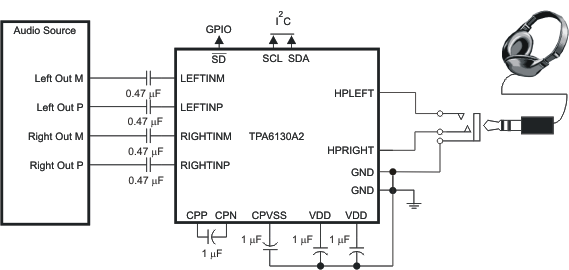SLOS488F November 2006 – March 2015 TPA6130A2
PRODUCTION DATA.
- 1 Features
- 2 Applications
- 3 Description
- 4 Simplified Schematic
- 5 Revision History
- 6 Pin Configuration and Functions
- 7 Specifications
- 8 Detailed Description
- 9 Applications and Implementation
- 10Power Supply Recommendations
- 11Layout
- 12Device and Documentation Support
- 13Mechanical, Packaging, and Orderable Information
封装选项
机械数据 (封装 | 引脚)
散热焊盘机械数据 (封装 | 引脚)
- RTJ|20
订购信息
1 Features
- DirectPath™ Ground-Referenced Outputs
- Eliminates Output DC Blocking Capacitors
- Reduces Board Area
- Reduces Component Height and Cost
- Full Bass Response Without Attenuation
- Power Supply Voltage Range: 2.5 V to 5.5 V
- 64 Step Audio Taper Volume Control
- High Power Supply Rejection Ratio
(>100 dB PSRR) - Differential Inputs for Maximum Noise Rejection (68 dB CMRR)
- High-Impedance Outputs When Disabled
- Advanced Pop and Click Suppression Circuitry
- Digital I2C Bus Control
- Per Channel Mute and Enable
- Software Shutdown
- Multi-Mode Support: Stereo HP, Dual Mono HP, and Single-Channel BTL Operation
- Amplifier Status
- Space Saving Packages
- 20 Pin, 4 mm x 4 mm QFN
- 16 ball, 2 mm x 2 mm DSBGA
- ESD Protection of 8 kV HBM and IEC Contact
2 Applications
- Mobile Phones
- Portable Media Players
- Notebook Computers
- High Fidelity Applications
3 Description
The TPA6130A2 is a stereo DirectPath™ headphone amplifier with I2C digital volume control. The TPA6130A2 has minimal quiescent current consumption, with a typical IDD of 4 mA, making it optimal for portable applications. The I2C control allows maximum flexibility with a 64 step audio taper volume control, channel independent enables and mutes, and the ability to configure the outputs into stereo, dual mono, or a single receiver speaker BTL amplifier that drives 300 mW of power into 16 Ω loads.
The TPA6130A2 is a high fidelity amplifier with an SNR of 98 dB. A PSRR greater than 100 dB enables direct-to-battery connections without compromising the listening experience. The output noise of 9 μVrms (typical A-weighted) provides a minimal noise background during periods of silence. Configurable differential inputs and high CMRR allow for maximum noise rejection in the noisy environment of a mobile device.
TPA6130A2 packaging includes a 2 by 2 mm chip-scale package, and a 4 by 4 mm QFN package.
Device Information(1)
| PART NUMBER | PACKAGE | BODY SIZE (NOM) |
|---|---|---|
| TPA6130A2 | WQFN (20) | 4.00mm x 4.00mm |
| DSBGA (16) | 2.00mm x 2.00mm |
- For all available packages, see the orderable addendum at the end of the datasheet.
4 Simplified Schematic
